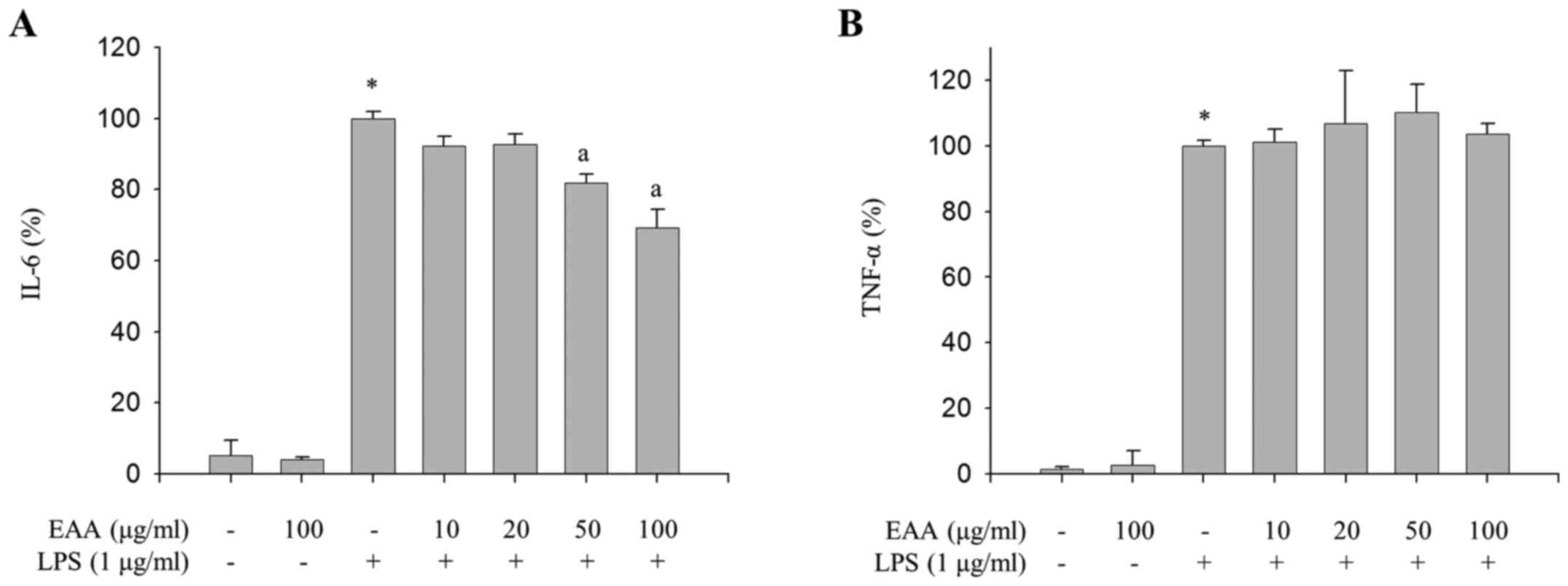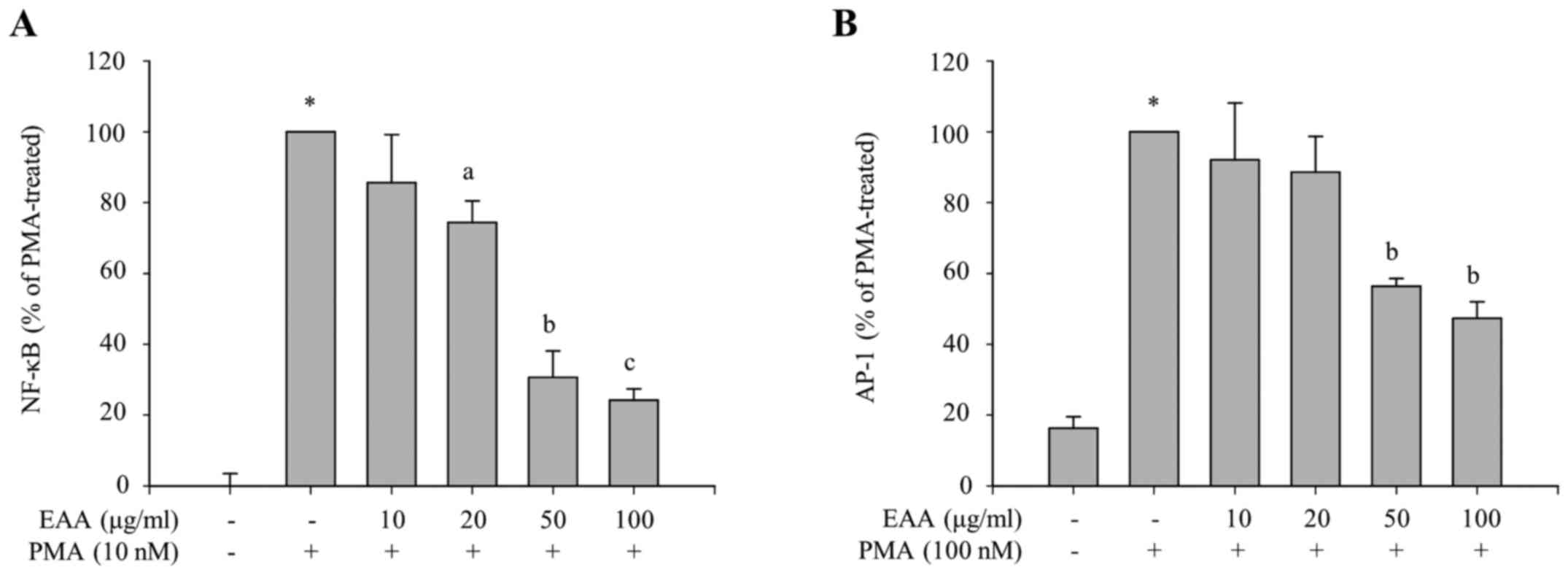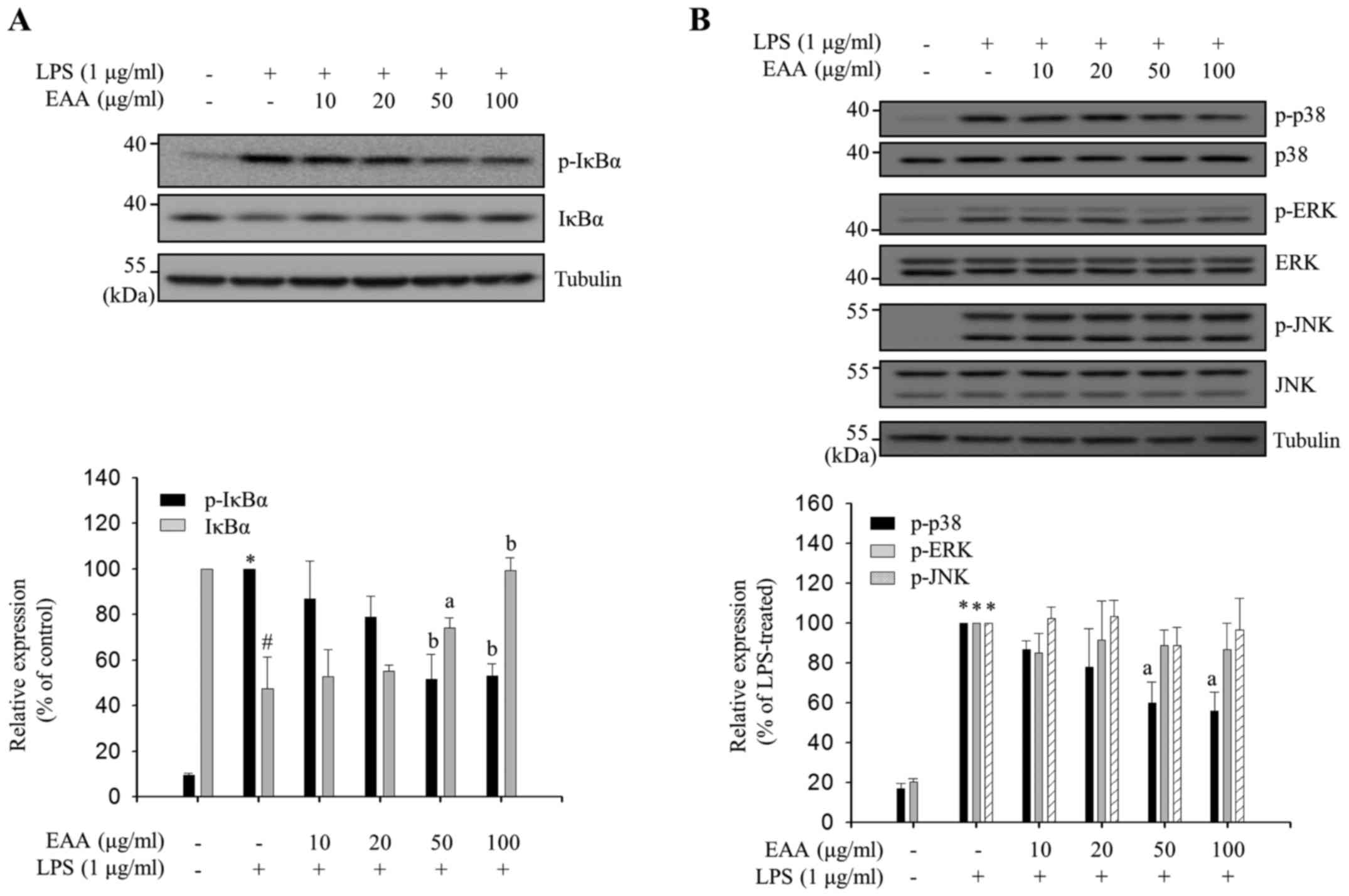|
1
|
Nowarski R, Gagliani N, Huber S and
Flavell RA: Innate immune cells in inflammation and cancer. Cancer
Immunol Res. 1:77–84. 2013. View Article : Google Scholar : PubMed/NCBI
|
|
2
|
Wu LC, Fan NC, Lin MH, Chu IR, Huang SJ,
Hu CY and Han SY: Anti-inflammatory effect of spilanthol from
Spilanthes acmella on murine macrophage by down-regulating
LPS-induced inflammatory mediators. J Agric Food Chem.
56:2341–2349. 2008. View Article : Google Scholar : PubMed/NCBI
|
|
3
|
Cutolo M: Macrophages as effectors of the
immunoendocrinologic interactions in autoimmune rheumatic diseases.
Ann N Y Acad Sci. 876:32–42. 1999. View Article : Google Scholar : PubMed/NCBI
|
|
4
|
Adcock IM: Transcription factors as
activators of gene transcription: AP-1 and NF-kappa B. Monaldi Arch
Chest Dis. 52:178–186. 1997.PubMed/NCBI
|
|
5
|
Karin M and Ben-Neriah Y: Phosphorylation
meets ubiquitination: The control of NF-[kappa]B activity. Annu Rev
Immunol. 18:621–663. 2000. View Article : Google Scholar : PubMed/NCBI
|
|
6
|
Wisdom R: AP-1: One switch for many
signals. Exp Cell Res. 253:180–185. 1999. View Article : Google Scholar : PubMed/NCBI
|
|
7
|
Park SY, Choi YH and Lee W: Dangnyohwan
improves glucose utilization and reduces insulin resistance by
increasing the adipocyte-specific GLUT4 expression in Otsuka
Long-Evans Tokushima Fatty rats. J Ethnopharmacol. 115:473–482.
2008. View Article : Google Scholar : PubMed/NCBI
|
|
8
|
Wang Y, Dan Y, Yang D, Hu Y, Zhang L,
Zhang C, Zhu H, Cui Z, Li M and Liu Y: The genus Anemarrhena Bunge:
A review on ethnopharmacology, phytochemistry and pharmacology. J
Ethnopharmacol. 153:42–60. 2014. View Article : Google Scholar : PubMed/NCBI
|
|
9
|
Yeum HS, Lee YC, Kim SH, Roh SS, Lee JC
and Seo YB: Fritillaria cirrhosa, Anemarrhena asphodeloides,
Lee-Mo-Tang and cyclosporine a inhibit ovalbumin-induced eosinophil
accumulation and Th2-mediated bronchial hyperresponsiveness in a
murine model of asthma. Basic Clin Pharmacol Toxicol. 100:205–213.
2007. View Article : Google Scholar : PubMed/NCBI
|
|
10
|
Sun H, Li TJ, Sun LN, Qiu Y, Huang BB, Yi
B and Chen WS: Inhibitory effect of traditional Chinese medicine
Zi-Shen Pill on benign prostatic hyperplasia in rats. J
Ethnopharmacol. 115:203–208. 2008. View Article : Google Scholar : PubMed/NCBI
|
|
11
|
Lee HJ and Ryu JH: Hinokiresinol: A novel
inhibitor of LTB4 binding to the human neutrophils. Planta Med.
65:3911999. View Article : Google Scholar : PubMed/NCBI
|
|
12
|
Garcia D, Delgado R, Ubeira FM and Leiro
J: Modulation of rat macrophage function by the Mangifera indica L.
extracts Vimang and mangiferin. Int Immunopharmacol. 2:797–806.
2002. View Article : Google Scholar : PubMed/NCBI
|
|
13
|
Kim JY, Shin JS, Ryu JH, Kim SY, Cho YW,
Choi JH and Lee KT: Anti-inflammatory effect of anemarsaponin B
isolated from the rhizomes of Anemarrhena asphodeloides in
LPS-induced RAW 264.7 macrophages is mediated by negative
regulation of the nuclear factor-kappaB and p38 pathways. Food Chem
Toxicol. 47:1610–1617. 2009. View Article : Google Scholar : PubMed/NCBI
|
|
14
|
Lu WQ, Qiu Y, Li TJ, Tao X, Sun LN and
Chen WS: Timosaponin B-II inhibits pro-inflammatory cytokine
induction by lipopolysaccharide in BV2 cells. Arch Pharm Res.
32:1301–1308. 2009. View Article : Google Scholar : PubMed/NCBI
|
|
15
|
Cho YC, Ju A, Kim BR and Cho S:
Anti-inflammatory effects of Crataeva nurvala Buch. Ham. are
mediated via inactivation of ERK but not NF-κB. J Ethnopharmacol.
162:140–147. 2015. View Article : Google Scholar : PubMed/NCBI
|
|
16
|
Feghali CA and Wright TM: Cytokines in
acute and chronic inflammation. Front Biosci. 2:d12–d26. 1997.
View Article : Google Scholar : PubMed/NCBI
|
|
17
|
Karin M and Delhase M: The I kappa B
kinase (IKK) and NF-kappa B: Key elements of proinflammatory
signalling. Semin Immunol. 12:85–98. 2000. View Article : Google Scholar : PubMed/NCBI
|
|
18
|
Connelly L, Palacios-Callender M, Ameixa
C, Moncada S and Hobbs AJ: Biphasic regulation of NF-kappa B
activity underlies the pro- and anti-inflammatory actions of nitric
oxide. J Immunol. 166:3873–3881. 2001. View Article : Google Scholar : PubMed/NCBI
|
|
19
|
Cuccurullo C, Mezzetti A and Cipollone F:
COX-2 and the vasculature: Angel or evil? Curr Hypertens Rep.
9:73–80. 2007. View Article : Google Scholar : PubMed/NCBI
|
|
20
|
Asehnoune K, Strassheim D, Mitra S, Kim JY
and Abraham E: Involvement of reactive oxygen species in Toll-like
receptor 4-dependent activation of NF-kappa B. J Immunol.
172:2522–2529. 2004. View Article : Google Scholar : PubMed/NCBI
|
|
21
|
Camacho-Barquero L, Villegas I,
Sánchez-Calvo JM, Talero E, Sánchez-Fidalgo S, Motilva V and
Alarcón de la Lastra C: Curcumin, a Curcuma longa constituent, acts
on MAPK p38 pathway modulating COX-2 and iNOS expression in chronic
experimental colitis. Int Immunopharmacol. 7:333–342. 2007.
View Article : Google Scholar : PubMed/NCBI
|
|
22
|
Garcia-Mediavilla V, Crespo I, Collado PS,
Esteller A, Sánchez-Campos S, Tuñón MJ and González-Gallego J: The
anti-inflammatory flavones quercetin and kaempferol cause
inhibition of inducible nitric oxide synthase, cyclooxygenase-2 and
reactive C-protein, and down-regulation of the nuclear factor
kappaB pathway in Chang Liver cells. Eur J Pharmacol. 557:221–229.
2007. View Article : Google Scholar : PubMed/NCBI
|
|
23
|
Tiwari M, Dwivedi UN and Kakkar P:
Tinospora cordifolia extract modulates COX-2, iNOS, ICAM-1,
pro-inflammatory cytokines and redox status in murine model of
asthma. J Ethnopharmacol. 153:326–337. 2014. View Article : Google Scholar : PubMed/NCBI
|
|
24
|
Sweet MJ and Hume DA: Endotoxin signal
transduction in macrophages. J Leukoc Biol. 60:8–26.
1996.PubMed/NCBI
|
|
25
|
Gabay C: Interleukin-6 and chronic
inflammation. Arthritis Res Ther. 8 Suppl 2:S32006. View Article : Google Scholar : PubMed/NCBI
|
|
26
|
LeMay LG, Vander AJ and Kluger MJ: The
effects of pentoxifylline on lipopolysaccharide (LPS) fever, plasma
interleukin 6 (IL 6) and tumor necrosis factor (TNF) in the rat.
Cytokine. 2:300–306. 1990. View Article : Google Scholar : PubMed/NCBI
|
|
27
|
Kawai T and Akira S: The role of
pattern-recognition receptors in innate immunity: Update on
Toll-like receptors. Nat Immunol. 11:373–384. 2010. View Article : Google Scholar : PubMed/NCBI
|













